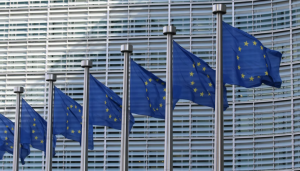Compaq Turns 30: A Brief History of Texas’ Digital Gusher
![]() The Compaq Alumni Group announced in early October that they will be celebrating the Compaq 30th Anniversary Reunion on November 4th, which also marks the 30th anniversary of the company’s first product, the Compaq Portable Computer, and the public announcement of the company name, Compaq Computer Corporation.
The Compaq Alumni Group announced in early October that they will be celebrating the Compaq 30th Anniversary Reunion on November 4th, which also marks the 30th anniversary of the company’s first product, the Compaq Portable Computer, and the public announcement of the company name, Compaq Computer Corporation.
The event will be held at Minute Maid Park in downtown Houston, and all former Compaq employees, along with a guest or spouse, are invited to attend the celebration. Attendees can register at the Compaq Alumni Group website. The event will be hosted by Rod Canion, co-founder and former CEO of Compaq.
A gold mine was born
On February 16, 1982, Gateway Technology was born of the minds of three former Texas Instruments employees at a table in a House of Pies on Westheimer Road in Houston. Rod Canion, James Harris and William Murto each had $1000 that they were willing to invest on managing a Mexican restaurant, making storage devices for minicomputers or, a beeping device to help locate lost items, but eventually settled with the idea of making a portable IBM PC.
![]() The name was changed to Compaq when they introduced their first product, the Compaq Portable Computer on November 4 1982. The introduction of the new portable computer came at a time in Texas when the price of oil was falling precipitously and the energy-centric economy was being dragged down with it.“The gusher of wealth that would flow from this new stream of electronic gold seemed very out of place in the ‘old economy’ corporate culture of ‘Big Energy’ Houston,” the Texas State Historical Association described of Compaq’s success.
The name was changed to Compaq when they introduced their first product, the Compaq Portable Computer on November 4 1982. The introduction of the new portable computer came at a time in Texas when the price of oil was falling precipitously and the energy-centric economy was being dragged down with it.“The gusher of wealth that would flow from this new stream of electronic gold seemed very out of place in the ‘old economy’ corporate culture of ‘Big Energy’ Houston,” the Texas State Historical Association described of Compaq’s success.
The name Compaq was said to be derived from the words Compatibility and Quality, but the explanation was said to be an afterthought. The name was one of the suggestions by Ogilvy & Mather, an international advertising, marketing and public relations agency based in Manhattan, and it was the least hated name on the list. Their first venture capital came from Benjamin M. Rosen and Sevin Rosen Funds who helped them secure $1.5 million in funding to produce their initial computer but they raised a total of $25 million from venture capitalists. This gave them the stability they needed, as well as providing assurances to the dealers or middlemen.
In just a year of operations, Compaq sold 53,000 units for sales of $111 million, and was the first start-up to reach the $100 million mark. The company went public in 1983 on the New York Stock Exchange, raising $67 million.
![]() In 1984, the company released the Compaq Deskpro, a 16-bit desktop computer using an Intel 8086 microprocessor running at 7.14 MHz. It was considerably faster than an IBM PC and was, like the Compaq Portable, also capable of running IBM software. It was Compaq’s first non-portable computer and began the Compaq Deskpro line of computers.
In 1984, the company released the Compaq Deskpro, a 16-bit desktop computer using an Intel 8086 microprocessor running at 7.14 MHz. It was considerably faster than an IBM PC and was, like the Compaq Portable, also capable of running IBM software. It was Compaq’s first non-portable computer and began the Compaq Deskpro line of computers.
In 1986, the company sold 150,000 PCs and enjoyed record sales of $329, making it the youngest-ever firm to land the Fortune 500 list in just four years of operations. It was also the year they introduced the first PC based on Intel‘s new 80386 microprocessor, the Compaq Deskpro 386, in 1986. It marked the first CPU change to the PC platform that was not initiated by IBM.
A year later, they hit the $1 billion revenue mark, taking the least amount of time to reach that milestone, and by 1991, Compaq held the fifth spot in the PC market with $3 billion in sales that year.
In 1989, they released the Compaq System Pro, a true server product with standard support for a second CPU and RAID, but also the first product to feature the EISA bus, designed in reaction to IBM’s MCA (MicroChannel Architecture) which was incompatible with the original AT bus.
![]() In the 1990s, they had a series of management shakeups and made a few important acquisitions including Tandem Computers, known for their NonStop server line that bolstered their presence in the business computing market. Another notable acquisition was the Digital Equipment Corporation for $9 billion.
In the 1990s, they had a series of management shakeups and made a few important acquisitions including Tandem Computers, known for their NonStop server line that bolstered their presence in the business computing market. Another notable acquisition was the Digital Equipment Corporation for $9 billion.
In 2002, they signed a merger with Hewlett-Packard for $24.2 billion that included $14.45 billion for goodwill, where each Compaq share would be exchanged for 0.6325 of a Hewlett-Packard share, and if either were to break the merger, they would have to pay a termination fee of $675 million. HP laid off a lot of Compaq employees and failed to merge Compaq’s computer assembly business to their lucrative printing and imaging division, and they were highly criticized for it. Compaq’s products took a backseat and lost the Compaq branding, eventually becoming a part of the Personal Systems Group, which former CEO Leo Apotheker wanted to spin off.
A message from John Furrier, co-founder of SiliconANGLE:
Your vote of support is important to us and it helps us keep the content FREE.
One click below supports our mission to provide free, deep, and relevant content.
Join our community on YouTube
Join the community that includes more than 15,000 #CubeAlumni experts, including Amazon.com CEO Andy Jassy, Dell Technologies founder and CEO Michael Dell, Intel CEO Pat Gelsinger, and many more luminaries and experts.
THANK YOU











